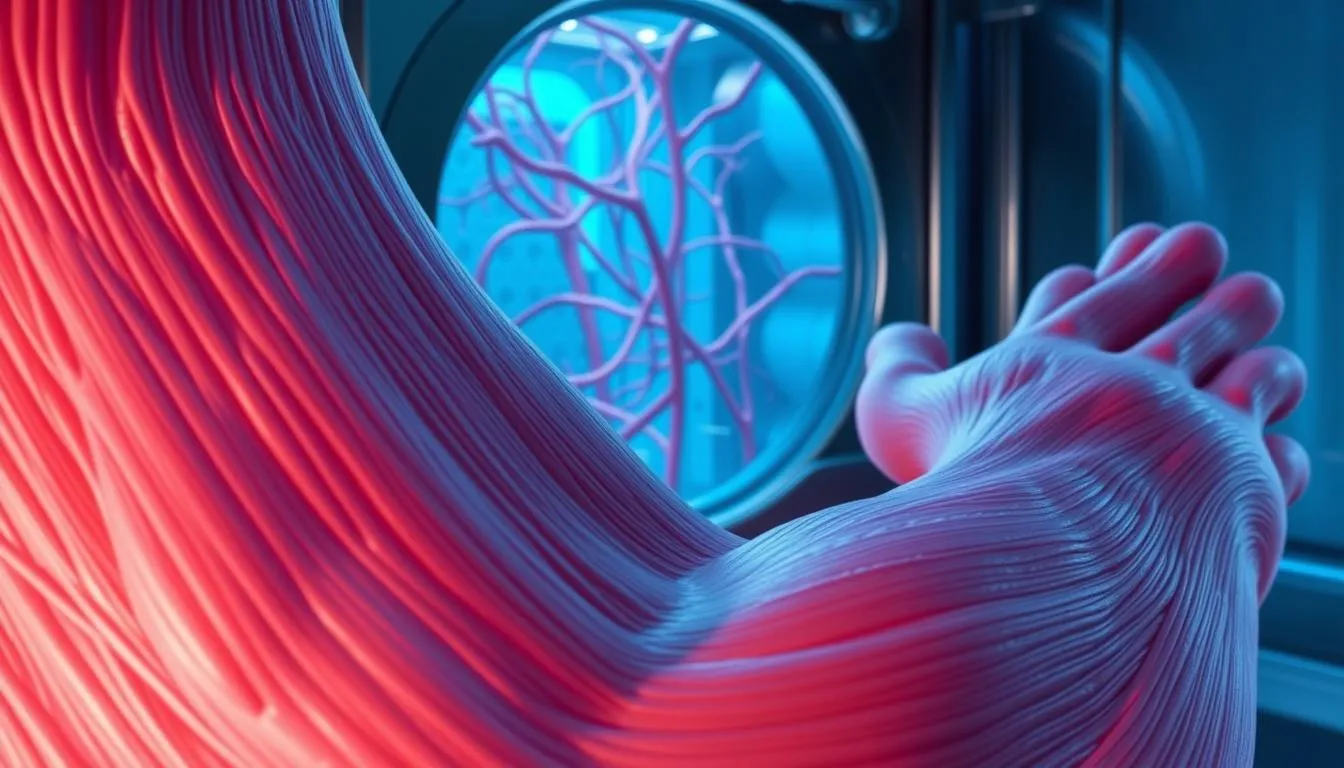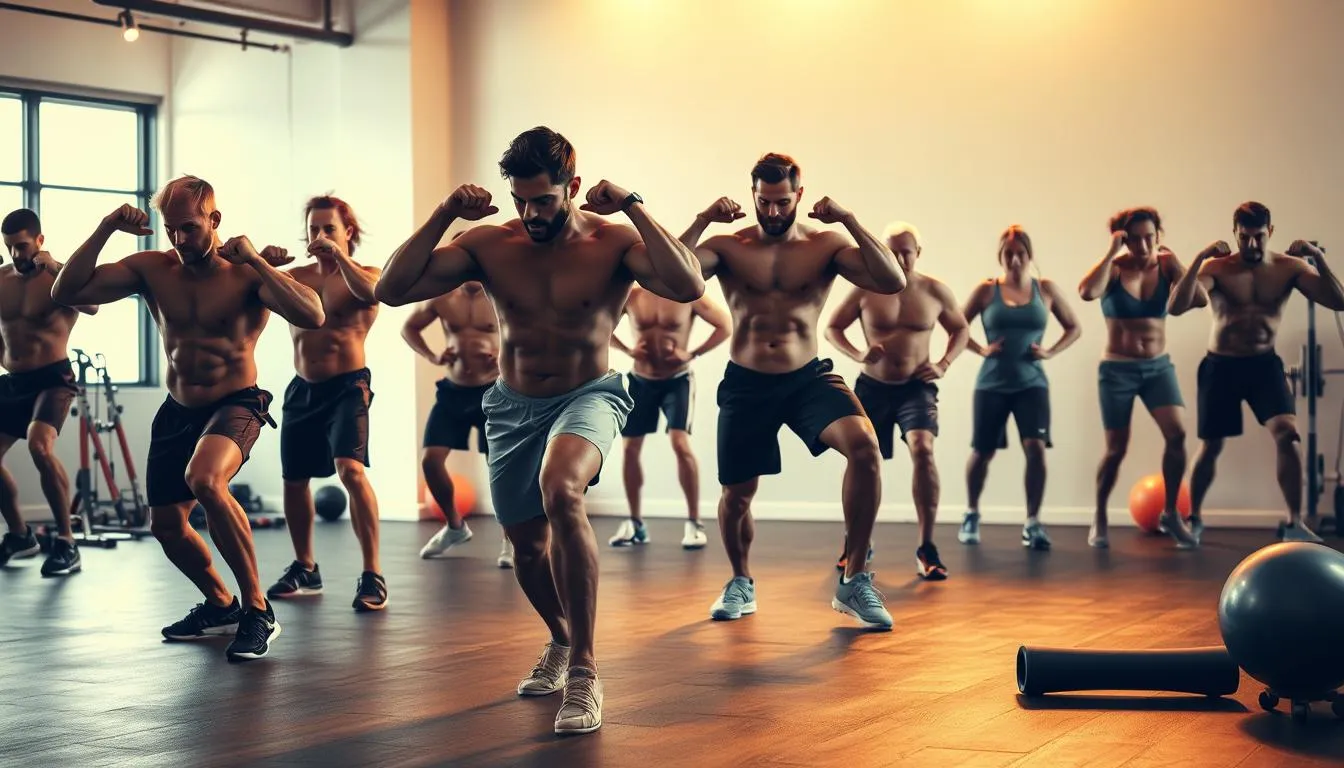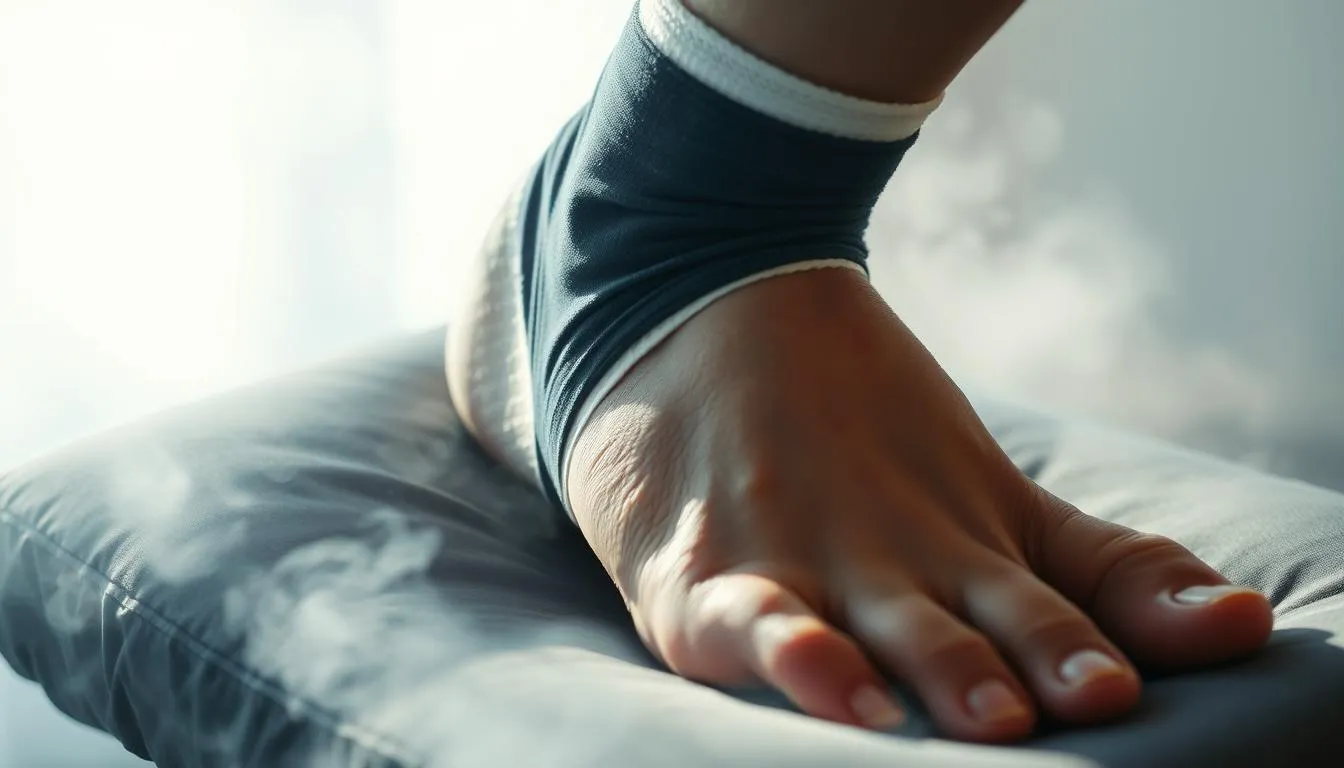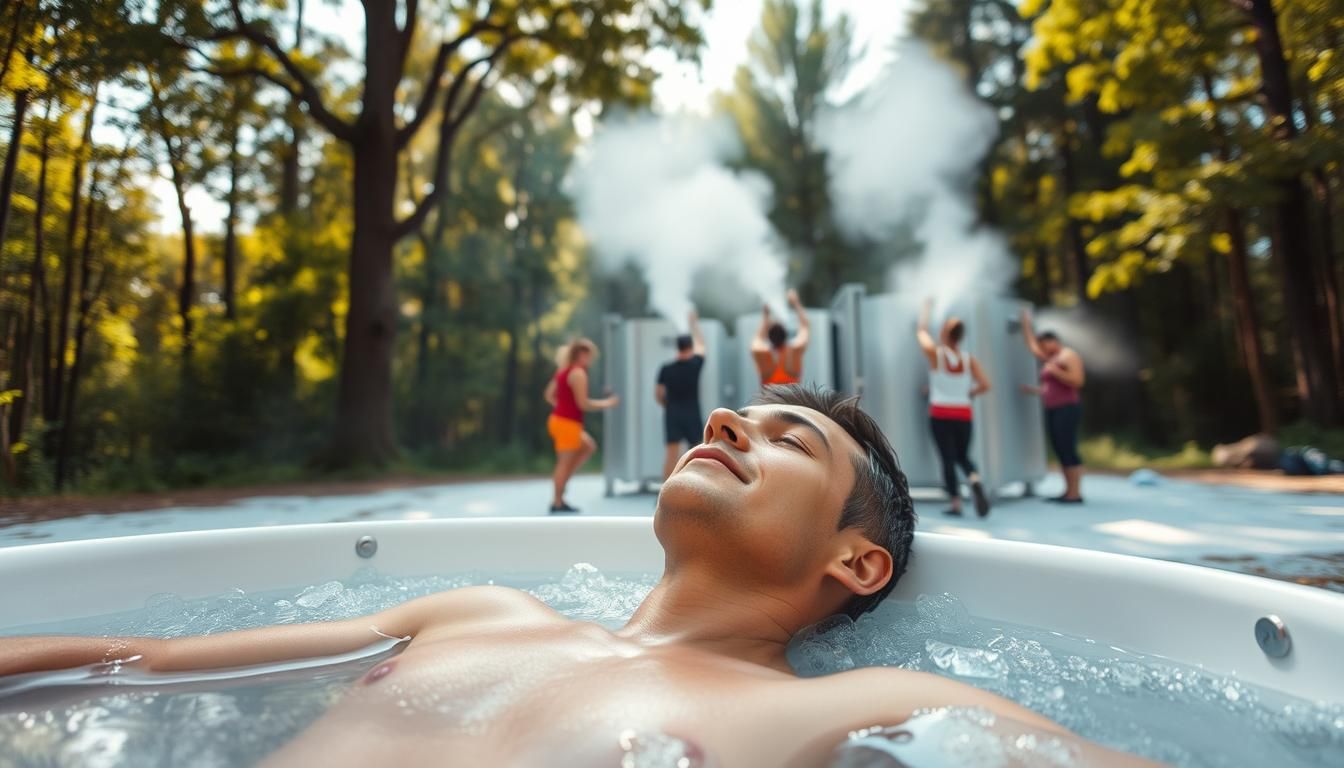I still remember the first time I iced my sore thigh after a hard workout — the cool bite felt like hope. Many of us chase quick fixes for muscle pain and want to return to training fast.
Current evidence shows common treatments such as massage, hyperbaric oxygen, and short cooling often offer limited gains for minor exercise-induced muscle damage.
This article will help you weigh safety and real benefits. We look at when cooling eases pain and when it might slow healing. The FDA warns about whole-body cold chambers and skin or neurologic risks, so safety matters.
We also cover practical, athlete-friendly strategies — from active recovery and targeted heat to compression, better massage practices, and wearable phase-change cooling shorts that showed improved thigh strength and less soreness in a small study. For comprehensive recovery approaches, explore immune recovery device technologies and lymphatic drainage therapy benefits.
Key Takeaways
- Human evidence finds limited benefit for minor muscle injuries from many popular treatments.
- Some wearable cooling methods showed modest gains in strength and soreness in athletes.
- Safety concerns exist for whole-body cold devices; follow FDA guidance.
- Active recovery, heat, compression, and guided massage are practical, low-risk options.
- This article blends peer-reviewed evidence and real-world tips for better recovery choices.
Understanding search intent: who this ultimate guide on cryotherapy alternatives is for
This guide is written for people who train hard and the professionals who support them. We focus on clear, practical advice to ease soreness and protect muscle function after exercise and sports injuries.
Athletes and active adults managing soreness and pain
If you are an athlete or active adult, expect step-by-step tips you can use the same day you train.
We translate studies into actions that preserve strength, cut down soreness, and speed safe return-to-play.
Clinicians and coaches seeking evidence-based recovery methods
This article helps clinicians and coaches match treatment choices to outcomes that matter: strength, function, and timing of return to sport.
We prioritize human studies, note where animal research suggests mechanisms, and highlight when an approach eases pain but might slow longer-term repair.
- When to use movement, heat, compression, or selective cooling.
- How to time interventions around exercise to maintain training momentum.
- Coach-ready checklists to monitor symptoms and function.
For a deeper read on device safety and protocols, see our ultimate guide. Use this article as a practical map to make confident, evidence-aware recovery choices.
Cryotherapy, explained: mechanisms, effects, and current evidence
A cold pack cools the surface quickly, yet deeper muscle temperature often barely budges in people.
Skin cools first. Cold triggers vasoconstriction and lowers skin temperature. That reduces local blood flow and can numb nerves, so pain falls quickly.

Why surface versus deep temperature matters
Human limbs are large and insulated. Typical icing rarely drops muscle below ~25°C. Animal experiments often reach 8–10°C, which changes inflammation more strongly.
What research shows in animals and people
Early rat studies found less leukocyte influx and lower intramuscular pressure at 24 hours after contusion. But repeated cooling for 28 days slowed satellite cell–driven regeneration and increased collagen, suggesting more scarring.
Human randomized trials and real-world studies generally report minimal gains in force recovery or soreness after exercise-induced damage. For a detailed review of safety and research, see a summary of human randomized trials on post-exercise cooling.
Risks, trade-offs, and practical framing
Reduced perfusion lowers oxygen and nutrient delivery. In short bursts this can limit swelling, but prolonged or deep cooling may blunt repair signals in muscle cells and risk delayed healing.
- Pain relief: Local nerve effects make cold feel helpful.
- Healing risk: Aggressive or long cooling can increase scarring in some injury types.
- Device cautions: Whole-body cold chambers can cause frostbite, neurologic events, skin reactions, and other complications.
Practical take-home: Use brief, localized cooling for short-term pain control. Then move to active methods that restore flow and support repair, and match the approach to the injury — contusion/crush may differ from micro-tears after exercise.
Cryotherapy alternatives
Good recovery focuses on easing discomfort while keeping the body’s healing signals active.
Key goal: reduce pain and swelling without blocking the cellular steps that rebuild strength.
Human-focused evidence suggests many popular treatments give limited benefit for minor exercise-induced muscle damage. That means favoring methods that preserve blood flow and repair.
Prioritizing practical, proven methods
- Choose active recovery, light heat, and graduated compression to speed waste clearance and nutrient delivery.
- Use targeted massage but avoid aggressive deep work that adds tissue stress.
- Apply brief, localized cooling for short-term pain relief; avoid long, deep icing that may blunt repair signals.
| Method | Primary benefit | When to use |
|---|---|---|
| Active recovery | Restores flow, reduces stiffness | Within 24–48 hours after exercise |
| Compression | Limits swelling, aids venous return | During rest and travel |
| 15°C wearable cooling | Reduced soreness, preserved strength in some studies | Post-match or when ice baths aren’t feasible |
Avoid relying on one tool. Combine light movement with compression or heat to address both function and comfort. Track soreness, swelling, and strength to tell if a plan is working.
When to see a clinician: increase in pain, loss of function, or signs of more than minor damage. Follow FDA cautions about whole-body cold devices and seek medical advice when in doubt.
Active recovery and exercise therapy for muscle repair
Gentle movement is one of the most practical ways to protect strength while tissue heals. Low-intensity exercise boosts blood flow and delivers oxygen and nutrients to injured muscle without adding new damage.
Start within 24 hours after hard eccentric work with easy options: light cycling, walking, or pool work. Keep perceived exertion low and stop if pain spikes.

How to dose movement
Use short, frequent sessions (10–20 minutes several times daily) to maintain neuromuscular activation and limit force loss. After eccentric damage, force can fall 15–60% and often needs 3–14 days to normalize, so steady, gentle work smooths that curve.
Progression and checks
Progress loading over several days based on soreness and function. Use simple readiness tests: pain-free range of motion and easy submaximal strength. If function declines, reduce intensity and consult a clinician.
- Pair movement with breathing drills and mobility work to restore coordination and tissue glide.
- Try a warm environment or light heat before activity to ease stiffness, then reassess sensation and soreness after each session.
- Remember: small, frequent bouts beat one long session; massage shows limited force recovery benefit up to 96 hours, reinforcing active approaches.
For practical protocols and sport-specific options, see recovery techniques for athletes.
Heat therapy: when warming beats cooling
Warming a sore area can do more than soothe — it changes tissue behavior and prepares muscles for movement.
How heat helps: Gentle heat raises local temperature, improving tissue extensibility and reducing stiffness. That makes movement less painful and helps the muscle tolerate light loading.
After the initial inflammatory peak has passed, warm packs or a shower increase blood flow without the vasoconstriction seen with ice. Better flow delivers oxygen and nutrients that support healing.
Timing and practical tips
Use 10–20 minutes of moist heat before mobility work or light strength sessions. Heat often eases pain and expands range of motion, so active recovery becomes more productive.
Try moist heat packs, warm baths, or heated compresses, and always check skin sensation. People with reduced feeling or fragile skin should test temperature carefully.
- Apply heat before exercise; reassess pain and function.
- If pain spikes, a brief localized cool-down may help, then return to movement.
- Heat is especially useful when you feel “tight” the next day — it makes early movement safer and more effective.
Compression and elevation to manage swelling and blood flow
Smart use of compression and elevation helps the limb clear excess fluid after sport or injury.
 Why it works: Graduated compression squeezes the limb gently from distal to proximal. This assists venous return and limits fluid build-up in the affected area. That reduces swelling without the deep cooling effects that icing can cause in muscle repair.
Why it works: Graduated compression squeezes the limb gently from distal to proximal. This assists venous return and limits fluid build-up in the affected area. That reduces swelling without the deep cooling effects that icing can cause in muscle repair.
Practical fit, timing, and safe use
Choose garments that feel snug but not painful. For athletic recovery, aim for 15–30 mmHg at the ankle or 10–20 mmHg for thigh sleeves to balance comfort and benefit.
Pair compression with elevation after practice or games to use gravity and help lymphatic flow. Use compression during travel or long sitting to keep blood moving and protect recovery momentum.
| Goal | Recommendation | When to stop or reassess |
|---|---|---|
| Reduce swelling | Graduated sleeve, 15–30 mmHg (ankle), elevate 15–20 min | More swelling or numbness |
| Protect muscle function | Wear during rest and light activity; pair with short movement bouts | Pain increases or function worsens |
| Skin safety | Check skin under wrap daily; avoid pressure over bony areas | Irritation, blisters, or persistent redness |
Integrate short, gentle movement while wearing compression to amplify flow and reduce stiffness. Taper wear as swelling and symptoms ease, and consult a clinician if pain or swelling worsens.
Massage therapy: benefits, limitations, and best practices
Many athletes use targeted hands-on work to feel better after a hard session, but the real effects on strength are mixed. Massage can ease perceived tightness and pain, yet randomized human studies report limited, inconsistent restoration of force up to 72–96 hours after exercise.
What human studies show on muscle soreness and force recovery
Evidence from trials finds modest reductions in muscle soreness for some people, but most studies do not show large improvements in strength in the first few days after damage.
Signals from mechanotransduction and inflammation modulation
Biopsy-based studies found brief post-exercise massage lowered TNF-α and IL-6 and reduced stress-protein phosphorylation while raising PGC-1α. These changes suggest altered inflammation and potential mitochondrial benefits, though clear links to early force gains remain unproven.
Practical guidance: technique, timing, and combining with light exercise
Use lighter strokes early and avoid aggressive deep pressure on very tender spots. Target surrounding fascia to improve glide and reduce perceived tightness without overloading damaged fibers.
- Keep sessions short (≈10 minutes) and reassess pain after treatment.
- Combine brief massage with light movement to reinforce comfort and mobility.
- Expect improved readiness to move rather than dramatic performance recovery in the first days.
Hyperbaric oxygen therapy: promising adjunct for severe injuries
Hyperbaric oxygen therapy (HBOT) raises dissolved oxygen in the blood by delivering 100% oxygen at pressures above one atmosphere. This higher oxygen load can alter how injured muscle repairs itself.
How it works: extra oxygen improves tissue perfusion and can push satellite cells from quiescence into repair. Animal models report earlier cell activation, higher IGF-1 expression, less edema, and faster strength gains after crush or contusion when protocols like 2.5 atm for 120 minutes daily for five days are used.
Evidence split
Human studies of minor exercise damage generally show no clear benefit in soreness, strength, swelling, or blood markers after HBOT. By contrast, preclinical and severe injury studies demonstrate meaningful regenerative effects.
Safety, access, and candidacy in the U.S.
HBOT is indication-based, requires facility screening, and trained supervision. Consider it as an adjunct for significant trauma, not routine post-workout care.
- Weigh cost, chamber time, and logistics against expected gains.
- Coordinate with a physician, especially with lung or cardiac issues.
- Track functional recovery (strength, mobility) over biomarkers to judge benefit.
Bottom line: HBOT can improve oxygenation and aid regeneration in severe models, but current human evidence does not support it as first-line treatment for everyday sports soreness.
Red light therapy and photobiomodulation for inflammation and tissue healing
Photobiomodulation delivers low-level red and near-infrared light to the skin and nearby tissue as a non-cooling method that may support recovery. Clinicians use LED or low-power laser devices to stimulate cell pathways without heat or extreme cold.Potential effects on oxidative stress, collagen, and recovery
How it may work: light can change mitochondrial activity and reduce oxidative stress in the skin and superficial layers. That shift may promote collagen remodeling and downstream tissue repair.
Positioning RLT alongside other non-cooling treatments
Early research shows benefits for skin integrity, wound healing, and localized discomfort, but robust performance data for muscle recovery is still emerging. Use RLT as a complement to movement, heat, and compression rather than a replacement.
- Common practice uses consistent dosing (several minutes, multiple sessions weekly) to build effects over time.
- Safety is favorable compared with whole-body cold exposure; there is no frost risk or extreme temperature stress.
- Clinicians may try RLT when pain limits active recovery, using it as a bridge back to movement.
Practical tip: track symptoms and function to see if RLT adds measurable benefits. Continued research must clarify ideal wavelengths, durations, and outcomes for athletic recovery and healing.
Wearable cooling with phase change materials: a practical middle ground
Wearable phase-change cooling gives teams a middle path between brief icing and complex cold chambers. These garments hold a steady 15°C for about three hours after a match. They aim to ease discomfort while letting repair processes continue.
Extended 15°C cooling and the impact on post-match strength and soreness
Study design and key findings: In a crossover study of 11 U23 soccer players, shorts lined with phase-change material were worn for ~3 hours post-match. At 36 hours, dominant thigh strength was >10% higher and reported muscle soreness was ~10% lower versus room-temperature control shorts. The garments offer steady cooling without the logistics of ice baths or extreme chambers.
Use cases: travel, away games, and when ice baths aren’t feasible
Wearable cooling fits tournaments, long travel, and venues with no ice or special equipment. Athletes tolerate steady 15°C better than intermittent cold or full immersion, which helps adherence.
| Feature | Benefit | Best use |
|---|---|---|
| 15°C steady temperature | Modest soreness reduction, preserved strength | Post-match recovery (3-hour wear) |
| Portable garment | No pool or chamber needed; easy transport | Away games, travel, tournaments |
| Comfort and adherence | Higher real-world use and consistent dosing | Teams standardizing routines |
Pair wearable cooling with light movement and compression to support blood flow and muscle recovery. Track individual responses—soreness, sleep, and next-day performance—to judge value. While findings are promising, more study is needed to compare this method directly with ice baths and other cooling approaches.
Nutrition and adjunct treatments that support recovery
Good recovery starts with food, sleep, and small daily habits that let muscle repair do its work.
Foundations matter: spread 20–40 g of protein across meals, stay hydrated, and protect sleep. Those steps fuel muscle protein synthesis and speed healing after exercise.
Protein, sleep, and anti-inflammatory eating
Choose omega-3s, colorful produce, and whole foods to help modulate inflammation and pain without blocking adaptive repair. Simple post-workout meals that balance protein and carbs stabilize blood sugar and give energy for healing.
Pharmacologic options and cautions
Avoid routine high-dose NSAID use right after training. While they cut pain, they can blunt the signals that build stronger muscle. Talk to a clinician before combining drugs with other treatments, especially with health issues.
- Limit caffeine and alcohol near bedtime to protect sleep.
- Use gentle heat, compression, and selective manual therapy to reduce muscle soreness and enable movement.
- Listen to pain—scale activity to avoid extra tissue stress.
Sample routine: protein-rich meal, warm shower, light mobility, optional brief localized cooling for pain, and early bedtime. Consistent habits beat occasional high-tech fixes for most minor strains.
Conclusion
Practical recovery focuses on keeping blood moving, protecting tissue, and choosing low‑risk treatments that help function.
Key evidence shows limited gains from extreme cooling, routine massage, or HBOT for minor exercise-induced muscle damage in humans. Avoid long, deep cold that can slow healing or harm skin and systemic safety.
Use active recovery, gentle heat, and graduated compression first. Brief, targeted ice or steady 15°C wearable cooling may help pain or strength in select cases, but findings are modest and need more research.
Prioritize sleep, protein, and progressive loading. Clinicians and coaches should match treatment to functional goals—strength, range, and readiness—and watch for strength loss, swelling, or persistent tenderness.
For severe injuries, consult a specialist about advanced options. Build a simple, evidence‑led playbook that supports healing with circulation, comfort, and patience.
FAQ
What simple methods reduce muscle pain and swelling without harming healing?
Low-intensity active recovery, compression garments, elevation, and targeted heat after the first 24–48 hours can lower pain and swelling while supporting blood flow and repair. Gentle movement boosts circulation and oxygen delivery without adding tissue damage, and graduated compression helps venous return and edema control.
Is short-term skin cooling useful for immediate pain relief?
Yes. Brief local cooling or an ice pack can reduce pain sensation by numbing nerve endings and shrinking superficial blood vessels, which eases discomfort after strong exercise or a minor sprain. Avoid prolonged deep cooling that may delay cellular repair in muscle tissue.
When is warming therapy preferable to cooling?
Warming works best once acute bleeding and major swelling have settled—typically after 48–72 hours. Heat increases blood flow, relaxes tissue, and improves range of motion, which helps healing, scar remodeling, and comfort during rehabilitation.
Can massage speed recovery from muscle soreness?
Evidence in humans shows massage can reduce perceived soreness and improve short-term force recovery. Benefits likely come from improved circulation, reduced stiffness, and mechanotransduction signals that modulate inflammation. Combine massage with light exercise for best results.
How does movement intensity and timing affect muscle repair?
Low- to moderate-intensity movement soon after exercise helps clear metabolites and brings oxygen-rich blood to damaged fibres. Avoid high-intensity loading during the early inflammatory phase, because heavy force can worsen damage and prolong weakness.
Are compression garments worth using after competition?
Yes for many athletes. Graduated compression reduces edema, supports venous return, and can decrease delayed onset muscle soreness. They are especially practical for travel or between games when active recovery is limited.
What role does nutrition play in tissue healing?
Adequate protein, regular sleep, and an anti-inflammatory dietary pattern support muscle repair. Protein supplies amino acids for satellite cell activity and collagen synthesis, while sleep promotes hormonal and immune processes linked to recovery.
Should athletes take NSAIDs to treat exercise-induced muscle damage?
Use caution. NSAIDs relieve pain and inflammation but may blunt some aspects of tissue repair if used long-term or immediately after injury. Reserve them for short-term symptom control and consult a clinician for repeated use or larger injuries.
What is hyperbaric oxygen therapy, and when is it appropriate?
Hyperbaric oxygen increases tissue oxygen availability to support cell regeneration and satellite cell function. It shows promise for severe crush or contusion injuries but has limited evidence for routine minor exercise damage. Access, cost, and medical candidacy are important considerations in the United States.
Does red light or photobiomodulation help muscle healing?
Photobiomodulation may reduce oxidative stress, support collagen formation, and lower inflammation in some studies. It can be a useful adjunct to other non-cooling treatments, but protocols and devices vary, so seek devices with clinical evidence and proper dosing guidance.
Are wearable cooling devices a good compromise to ice baths?
Wearable phase-change cooling offers extended, milder cooling (around 15°C) that can reduce soreness and post-match strength loss without the extremes of ice baths. They’re practical for travel and situations where immersion isn’t feasible, but they still cool tissue—use thoughtfully around healing timelines.
Can prolonged or deep cooling impair muscle repair?
Yes. Strong, prolonged cooling that lowers intramuscular temperature may delay inflammatory processes and satellite cell activity necessary for repair. Balance short-term pain relief against the potential for slower healing, especially after significant muscle injury.
How do human studies compare to animal research on cooling effects?
Animal studies often use deeper, colder protocols that aren’t directly comparable to human practice. Human trials tend to show modest pain relief but mixed effects on strength and long-term recovery. Prioritize interventions supported by human data when possible.
Can combining therapies improve outcomes?
Combining targeted approaches—such as gentle exercise, appropriate heat in later phases, compression, and nutrition—often offers better recovery than a single modality. Tailor combinations to the injury severity and timing: immediate comfort measures first, then circulation-promoting strategies.
When should I see a clinician rather than self-treat?
Seek medical care for severe pain, visible deformity, large swelling, numbness, loss of function, or if symptoms worsen after 48–72 hours. A clinician can rule out fractures or severe muscle tears and recommend imaging, physical therapy, or advanced treatments like hyperbaric oxygen if indicated.
